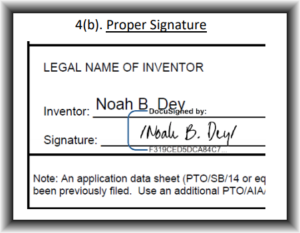
(Update: the USPTO has published yet another Federal Register Notice dated March 22, 2024, that permits use of commercial e-signing software with no requirement that the previously crucial virgules be inserted into the software e-signature. See blog article.)
On about June 9, 2020, the USPTO quietly decided to accept more kinds of e-signatures in addition to the well-known “virgule” signature.
Prior to September 21, 2004, the only signature USPTO was willing to recognize was a legacy handwritten pen-and-ink signature. In 2004 the USPTO carried out a rulemaking (69 FR 56481) that took effect on September 21, 2004. The rulemaking amended 37 CFR § 1.4 (“Rule 4”) to add a second permitted kind of signature namely the virgule (“slash”) signature. On October 27, 2004 the USPTO published a guidance document entitled “S-Signature Examples” which was intended to help USPTO people distinguish between e-signatures that the USPTO considers to be Rule-4 compliant and would-be e-signatures that USPTO considers to be non-compliant.
During the years from 2004 to 2013, USPTO has consistently bounced documents that had been e-signed in any way other than USPTO’s self-designed virgule style of e-signature. (And it has often bounced documents that have been e-signed compliantly with Rule 4; for example my e-signature is “/s/” which fully complies with Rule 4 but USPTO clerks often bounce documents e-signed that way. And Patentcenter bounces that e-signature despite its being Rule-4 compliant (trouble ticket CP29)).
In 2013 the USPTO carried out a second rulemaking (78 FR 62367) that took effect on on December 18, 2013 to permit inventors to e-sign using graphically inserted replicas of pen-and-ink signatures (see 37 CFR § 1.4(d)(3)).
And so things have stood from 2013 to the present day. USPTO’s unwillingness to recognize an e-signature carried out by any means other than USPTO’s own self-devised e-signature format, or the graphically inserted replica of a pen-and-ink signature, has been a point of contention in recent years for people within client corporations who are accustomed to being able to e-sign documents using platforms such as paid-for Acrobat and Docusign. For many years now, USPTO’s position has consistently been that an e-signature carried out by any means other than the virgule procedure set forth in Rule 4 or the replica signature is not a signature at all.
But not any longer. On about June 9, 2020 the USPTO quietly revised its guidance document “S-Signature Examples” to list several more permitted e-signature formats. You can see the new document on the USPTO web site here and you can see it archived here. As you may see at pages 5 through 9 of the guidance document, the USPTO now permits the use of systems such as Docusign and paid-for Acrobat to e-sign documents for e-filing at the USPTO. Newly permitted e-signature formats include the Docusign example quoted above.

The way that I learned about this is that I am subscribed to the EFS-Web listserv. Alert listserv member Jeffrey Kapteyn posted there that the USPTO had updated this guidance document. It was actually two-step process. It was alert listserv member Michael Nye who pointed out to me that alert listserv member had Jeffrey Kapteyn noticed the revised guidance document. Thank you Jeffrey and thank you Michael.
I leave it to the reader to consider whether a mere revision of this guidance document is in fact legally effective, or whether an amendment to Rule 4 pursuant to the Administrative Procedure Act would actually be required to bring about such a result.

Because that signature *is* a virgule signature, but generated using a Docusign-provided script font for the name, it’s not really a change to their rule. They’ve always (I think) accepted any font for the signature. The only difference is that the PTO is choosing to ignore the extraneous graphic and Docusign text, since that’s really just informative material that’s not part of the signature.
It looks like the digitally-signed typed signature must still include the slash marks, though it does not appear to be required for the stylus/mouse created digital signature. The guidance does note that the slash marks are not a part of the signature and can be typed by the attorney, but then it seems to suggest that the slash marks have to be there before the inventor applies the digital signature – not added after. So it doesn’t seem to help as much as one might want. The attorney still has to either know in advance how the inventor will sign it, or send the inventor a rather lengthy explanation of acceptable/unacceptable signature formats.